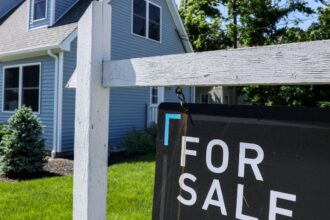When buying a home today, you might have to solve a puzzle about the mortgage rate you’ll pay. Which would you do?
A one-size-fits-all answer doesn’t exist, but it might be wise to lean toward paying discount points these days. Here’s how to make a decision that fits your circumstances.
Read: Americans expect mortgage rates to rise above 8% in the next 12 months, New York Fed housing survey finds
What are discount points?
Discount points are a fee paid to the lender to reduce the mortgage’s interest rate. One discount point equals 1% of the loan amount and typically reduces the interest rate by around a quarter of a percentage point. The rate reduction lasts for the life of the loan, and it’s sometimes called a “permanent buydown.”
Here’s an illustration you can try with a mortgage points calculator:
A buyer getting a $300,000 mortgage could pay $3,000 for one discount point to cut the mortgage rate from 7% to 6.75%. The monthly payment would shrink by $50. The accumulated monthly savings would exceed the upfront cost after 60 months for a five-year break-even period. Over those five years, you’d save $774 on interest (including the $3,000 in points, which are prepaid interest) and build up $768 more equity.
Discount points have become commonplace since mortgage rates jumped last spring. More than half of borrowers have paid discount points since then, according to data analytics company Black Knight.
As lenders compete for business, discount points may yield more bang for the buck. Nowadays, it’s not unusual for one point to reduce the rate by more than half a percentage point instead of the usual quarter of a percentage point, says Jim Sahnger, mortgage originator for C2 Financial Corp., in Jupiter, Florida. That shortens the break-even period.
Also on MarketWatch: ‘We’ve become a renting nation’: Landlords benefit from high house prices, but millions of renters find themselves trapped
When shopping mortgage offers, be aware that some of your rates may already include discount points. Make sure to find out the interest rate without discount points as well. That way, you can easily compare the impact of paying discount points with a no-points loan.
The customary way of thinking about it
The standard advice is to consider how long you intend to own the house.
“If the home buyer plans to move out of the home within a few years, it may be more beneficial to take on the higher rate,” instead of paying discount points, said Dan Hanson, loanDepot executive director of in-market retail, in an email.
But if you plan to own your place past the break-even period, you’ll save by paying discount points.
Other reasons to pay discount points
You may qualify for a bigger loan by paying discount points, Hanson noted. That’s because, with a lower interest rate, you can borrow more money for a given monthly payment. It could be enough to nudge a house from unaffordable to affordable.
Risk-averse home buyers might wish to buy down the interest rate, too.
Sonia Figueroa, an agent with EXP Realty in Chicago, put it this way in an email: “On a personal level, I would do a permanent buydown so I don’t have constant worry for the future, or worse, if I get sick or lose my job,” she said.
The case for seller-paid discount points
Some home sellers offer to contribute toward closing costs, and you can ask for such a concession during negotiations. You can spend the seller’s contribution on lender fees or divert it toward discount points.
If you need cash to fix up the house, you’ll probably spend the seller’s contribution on closing costs instead of discount points, said Sherry Chen, a San Diego-based Realtor with the Kappel Realty Group at Compass, in an email.
Some home buyers expect their incomes to fall because they’re “anticipating a retirement or stepping away from the workforce possibly due to having a child, or caring for an elderly or ill family member in the near future,” said Chuck Vander Stelt, a real estate agent in Valparaiso, Indiana, in an email. These buyers should consider using a seller concession to reduce the mortgage rate to avoid a financial pinch, he said.
Plus: Who is selling their homes in this uncertain housing market? The same people who are buying houses more than anyone else.
The case for waiting to refinance
There are three compelling reasons to reject discount points:
- You don’t have the cash to pay them, or you’d rather spend the money on fixing up the house.
- You intend to sell the house before the break-even period is over.
- You expect mortgage rates to fall substantially within two or three years when you’ll refinance at the lower interest rate.
Some loan officers and real estate agents advise clients to avoid discount points and instead spend the money on closing costs or home renovations or to set aside the money to pay fees on a mortgage refinance.
Note that you’re not guaranteed to have the opportunity to refinance to a lower interest rate in the next couple of years. The historical record isn’t encouraging. In the last decade, there have been only a few times when someone getting a mortgage would see rates fall at least 1.5 percentage points within two years of closing.
On the other hand, interest rates are higher today than during most of that period, so they have more room to fall.
Since you can’t know if or when interest rates will fall, it might be best to opt for the sure thing: a lower rate secured by paying discount points. That gives you lower monthly payments from the get-go. And you can refinance if interest rates fall far enough.
More From NerdWallet
Holden Lewis writes for NerdWallet. Email: [email protected]. Twitter: @HoldenL.
Read the full article here










